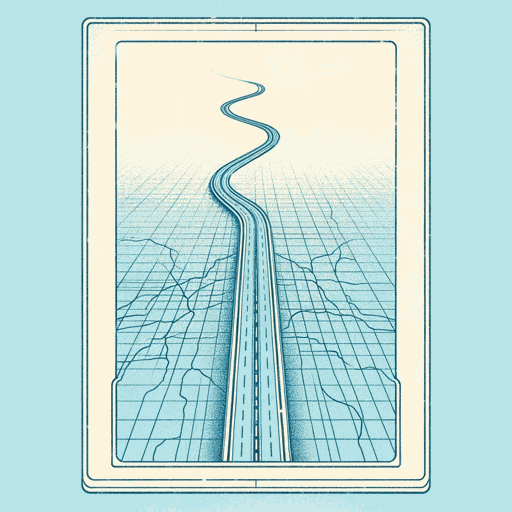46 pages • 1 hour read
William Least Heat-MoonBlue Highways: A Journey into America
Nonfiction | Autobiography / Memoir | Adult | Published in 1982A modern alternative to SparkNotes and CliffsNotes, SuperSummary offers high-quality Study Guides with detailed chapter summaries and analysis of major themes, characters, and more.
Summary and Study Guide
Overview
Blue Highways: A Journey into America (1982) is an autobiographical travelogue by American historian William Least Heat-Moon. The trip in question—a 13,000-mile circuit around the States—began in 1978, the book’s title deriving from out-of-the-way routes drawn in blue on an old road atlas. The author-narrator researches local history of the areas visited and interviews the many people he meets. Heat-Moon spent the subsequent years composing and revising the manuscript, and after a few rejections, it was accepted for publication, quickly thereafter reaching the New York Times bestseller list and receiving glowing praise from critics and casual readers alike.
The edition used for this study guide is the Kindle edition published by Little Brown and Company in April 2012.
Summary
As the book begins, Heat-Moon is at a crossroads in his life. He decides to undertake the ultimate road trip around the United States using only old state routes rather than the convenience and speed of the interstate system. He is spurred on to this decision by two ongoing hardships: his separation from his wife, and his recent layoff from his role as a community college instructor. Heat-Moon lives in Columbia, Missouri, and sets off on his journey in his 1975 Ford van nicknamed “Ghost Dancing.” The van’s interior has been transformed into a makeshift camper, and as Heat-Moon traverses the nation, he spends most nights there. He also brings along books: Whitman’s Leaves of Grass and John G. Neihardt’s Black Elk Speaks. Both books suggest a lot about Heat-Moon and hint at the true nature of his trip: This is a journey of self-discovery, one that will teach Heat-Moon valuable life lessons.
The chapter titles indicate the cardinal direction of his travel, and Chapter 1 is simply entitled “Eastward.” Throughout the whole journey, Heat-Moon encounters the populace of out-of-the-way places. Most of the people Heat-Moon meets are affable and willing to talk, recounting the stories of their lives—narratives that often provide glimpses into local history. The history of place and residents, past and present, is a major topic in the book. Ultimately, Heat-Moon uncovers in these people the pulse of a nation caught in the gray zones between heritage and the advance of modernity. In most cases, Heat-Moon presents these people with dignity: Though sometimes victimized by industrialism and cultural commercialization, they demonstrate strength and resolve.
Heat-Moon’s journey traces something of a circle around the map of the United States. He travels parallel to the borders of both Mexico and Canada and drives along both coasts. The narrative sometimes sounds like a deep philosophical piece, while sometimes it sounds like a historical guide. Still other times, it sounds like a personal journal. Heat-Moon’s fusion of these genres is part of what gives the book its life and freshness. The trip takes place in 1978, and the book was published in 1983—but for modern readers, it is sometimes easy to lose sight of this fact because much of Heat-Moon’s story has a timeless quality to it. He probes life’s deeper mysteries in many interior monologues throughout the narrative, and these monologues keep the book from feeling anachronistic. The book could be understood and enjoyed by younger generations for whom the 70s is ancient history.
Heat-Moon uses the term “blue highways” for any route on his road atlas that is colored blue; these routes are older, smaller, and less traveled than the interstate system (which Heat-Moon entirely despises). Following these blue highways therefore holds symbolism for the author, as they represent exploration and discovery—of both the world and himself. Heat-Moon intentionally keeps to the blue highways from the outset, consequently going into places that are totally off the main. He is careful not to hammer the message into the reader, and, while his narrative never becomes a self-help book, it has insights for those who are open to them.
At 38, Heat-Moon realizes that youth quickly vanishes. A tension exists between his cynicism about the modern world and his nostalgia for the old ways. He tends to romanticize the past, but he recognizes the inevitability of change, albeit begrudgingly. Heat-Moon ultimately seeks harmony between the old and the new, between heritage and commerce, between nature and industry. When he sees this rare harmony in the world, he posits it as evidence that there are better approaches to change than the reckless and prevalent “out-with-the-old / in-with-the-new” approach. This narrative spirit may invite the reader to self-reflect and scrutinize their own era’s ethos.
In the concluding chapter, Heat-Moon admits that his journey brought a complicated self-discovery. While he hadn’t aimed to learn anything in particular when he set out, he nevertheless learned what he hadn’t known he desired. While the admission reveals the author’s state of confusion prior to his trip, it also shows his humility. He does not pretend to have all the answers to the mysteries even of his own life—let alone the greatest mysteries of life in general. However, he delights in the search and in the wide range of perspectives that generations, current and past, have taken to understand their place in the universe. Blue Highways is a serious book, and through one man’s journey to discover himself, it gestures toward the blue highways of readers’ own lives.

